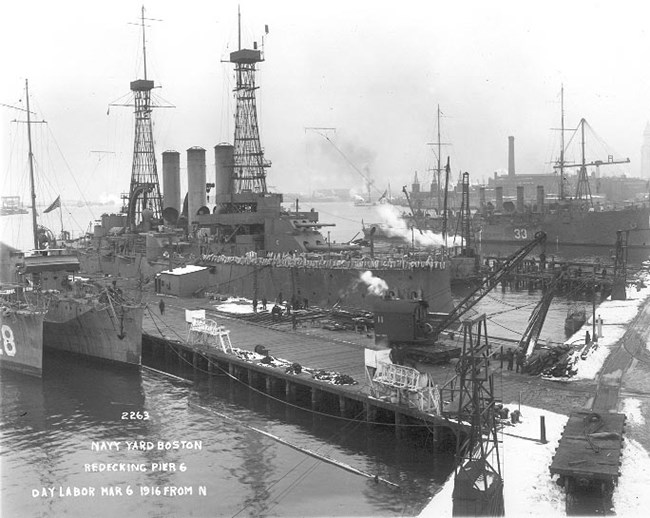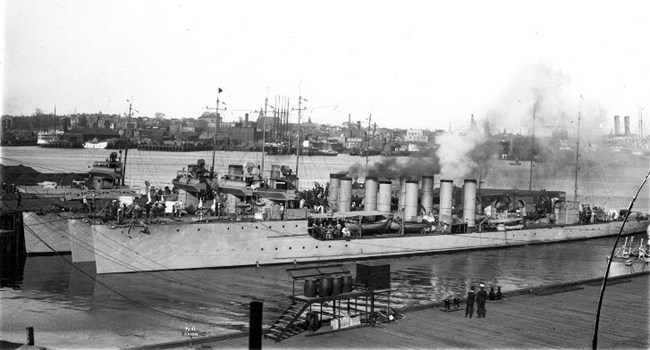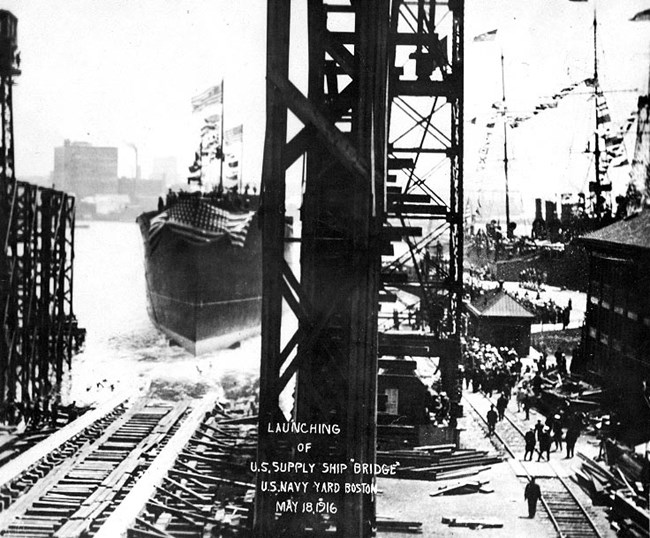Last updated: July 18, 2017
Article
Boston Navy Yard and the "Great War," 1914-1918

BOSTS 8756-2263
by David Hannigan, Park Guide
At the turn of the 20th century, the Boston Navy Yard (now known as Charlestown Navy Yard) entered its second century of service by embarking on its first major expansion since the Civil War. This growth was in line with the goals of President Theodore Roosevelt’s administration, which wanted the United States Navy to expand and modernize, heralding the emergence of America as a world power. In Boston several new buildings and a second dry dock were built to meet the demands of the growing fleet that it served.
Shortly after the outbreak of World War I in August 1914, President Woodrow Wilson declared that the United States would remain neutral. It would become the navy’s job to protect the nation’s neutrality at sea and at home by stationing destroyers at Boston Navy Yard.
In the aftermath of the sinking of the RMS Lusitania in May 1915, President Wilson sided with the growing number of advocates of military preparedness who sought to protect America’s interests at home and abroad. As part of the preparedness movement, Wilson called upon Congress to authorize the construction of over 150 warships. With the passage of the Naval Act of 1916, the Boston Navy Yard prepared for an increase in the number of ships built, outfitted, and repaired at the facility.
Throughout the war years, many of the yard’s older buildings were renovated or replaced, while several new buildings were erected, including a massive general storehouse. An inclined shipway, where vessels could be built and launched, was constructed and towering hammerhead cranes were erected after the Navy Department selected the Boston Navy Yard for the construction of the first ship specifically built to carry supplies and provisions for overseas fleet replenishment. For the repair of smaller vessels, a marine railway was constructed between the yard’s two dry docks.
As preparations intensified, the number of workers at the yard increased dramatically, growing from approximately 2,500 to 4,400 skilled and unskilled laborers by 1917. This workforce would come to include a number of women who filled a variety of roles from clerical workers to manufacturing assistants in the yard’s ropewalk, which had greatly increased its production of cordage for the navy.

BOSTS 14934-13
By January 1917, the land war in Europe had reached a stalemate, prompting Germany to resume its campaign of unrestricted submarine warfare in an attempt to cut off Britain’s supply lines and starve the country into submission before America joined the war. After the sinking of several American vessels with loss of life, the United States declared war on Germany on April 6 and rapidly began to mobilize its forces.
Immediately following the declaration of war, the United States Navy ordered Destroyer Division 8 to assemble at the Boston Navy Yard and prepare for deployment to European waters. Six destroyers departed Boston on April 24, 1917 and arrived at the British naval base at Queenstown (Cobh), Ireland on May 4. A second group of destroyers left Boston on May 7 to join in escort duties and patrol for German U-boats. Thereafter, the port of Boston and its navy yard would become one of the principal points of departure for troops, arms, and supplies to Britain and France.

BOSTS 10538
Though the Boston Navy Yard would build a number of support ships during the war, the Navy specifically assigned the yard the task of repairing warships and support vessels. Equally important, the yard oversaw the outfitting and commissioning of a steady stream of warships built by private shipbuilding concerns. These would include destroyers and submarines constructed at Bethlehem Shipbuilding Corporation’s Fore River Shipyard and its Victory Destroyer Plant, both located in Quincy, Massachusetts.
In addition to readying and repairing warships, workers at the Boston Navy Yard also outfitted ships of the American Merchant Marine with armament provided by the federal government. Boston also converted, fitted out, and commissioned former cargo carrying merchantmen and passenger vessels that had been purchased or leased by the Navy. The smaller and swifter vessels were converted for use in anti-submarine warfare and coastal patrol, while larger vessels were converted for use in transporting troops and carrying cargo. Perhaps the most complicated conversion work at the yard involved five German passenger ships that had been seized in American ports by the United States government after the declaration of war. Prior to the vessel’s seizure, their crews had sabotaged the ship’s’ engines, necessitating extensive repairs before these vessels could be transformed into transports to carry troops and supplies from the United States to France.
Sources:
- Charlestown Navy Yard 1800-1842, Vols. 1 & 2: Ed Bearss, Boston National Historical Park, 1984.
- Charlestown Navy Yard, NPS Handbook 152, US National Park Service, 1995.
- Charlestown Navy Yard Historic Resource Study Vols. 1-3: Stephen P. Carlson, Boston National Historical Park, 2010.
